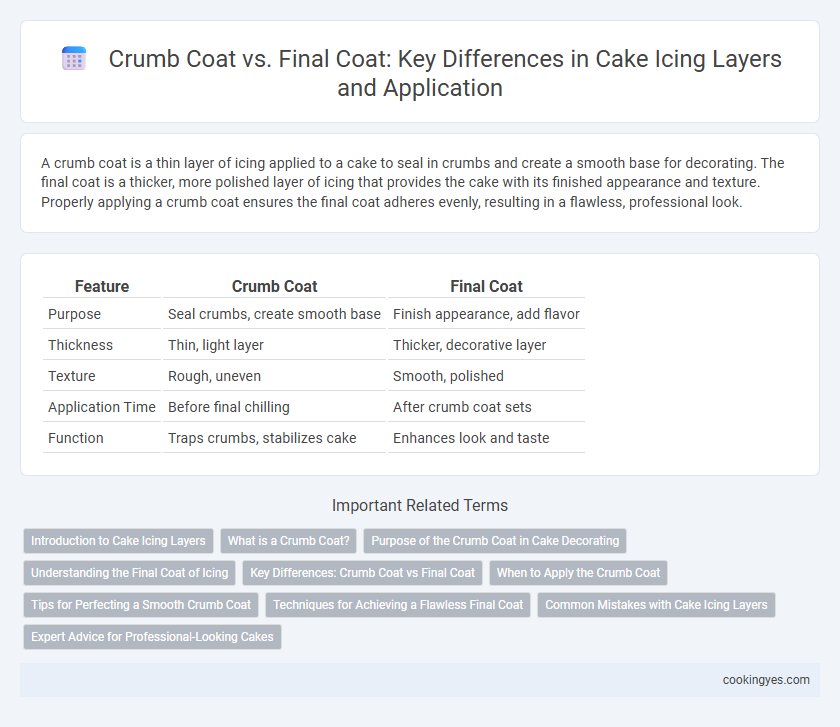A crumb coat is a thin layer of icing applied to a cake to seal in crumbs and create a smooth base for decorating. The final coat is a thicker, more polished layer of icing that provides the cake with its finished appearance and texture. Properly applying a crumb coat ensures the final coat adheres evenly, resulting in a flawless, professional look.
Table of Comparison
| Feature | Crumb Coat | Final Coat |
|---|---|---|
| Purpose | Seal crumbs, create smooth base | Finish appearance, add flavor |
| Thickness | Thin, light layer | Thicker, decorative layer |
| Texture | Rough, uneven | Smooth, polished |
| Application Time | Before final chilling | After crumb coat sets |
| Function | Traps crumbs, stabilizes cake | Enhances look and taste |
Introduction to Cake Icing Layers
Crumb coat is a thin, initial layer of icing applied to a cake to seal in crumbs and create a smooth base for the final coat. The final coat is a thicker, polished layer of icing that provides the cake's finished appearance and texture. Properly distinguishing between crumb coat and final coat ensures a clean, professional look for decorated cakes.
What is a Crumb Coat?
A crumb coat is a thin, initial layer of icing applied to a cake to seal in crumbs and create a smooth surface for the final coat. This layer ensures that loose crumbs do not mix with the outer decoration, resulting in a cleaner and more polished appearance. Typically, the crumb coat is chilled before applying the thicker, more decorative final coat of icing.
Purpose of the Crumb Coat in Cake Decorating
The crumb coat serves as a thin, initial layer of icing that traps loose crumbs, creating a smooth base before applying the final coat. This technique ensures a clean, even surface for the outer decoration, preventing crumbs from mixing into the final layer. Proper crumb coating enhances the overall appearance and texture of decorated cakes by providing structural stability.
Understanding the Final Coat of Icing
The final coat of icing, also known as the finishing layer, provides a smooth and polished appearance while sealing in the cake's moisture. Unlike the crumb coat, which traps loose crumbs to create a clean base, the final coat is applied more carefully to achieve an even texture and flawless finish. Selecting a suitable icing type, such as buttercream or fondant, enhances the durability and aesthetic appeal of the cake's exterior.
Key Differences: Crumb Coat vs Final Coat
The crumb coat is a thin, initial layer of icing designed to trap loose crumbs and create a smooth base for the final decoration. In contrast, the final coat is a thicker, smoother layer applied after the crumb coat has set, providing the cake with its polished, finished appearance and enhancing flavor and texture. The crumb coat emphasizes crumb containment, while the final coat focuses on visual appeal and structural integrity.
When to Apply the Crumb Coat
Apply the crumb coat immediately after the cake layers are stacked and trimmed to lock in loose crumbs and create a smooth base for the final coat. This thin layer of icing should be chilled for at least 15-30 minutes to set properly before applying the thicker, polished final coat. Using the crumb coat prevents crumbs from mixing into the final layer, ensuring a clean, professional finish.
Tips for Perfecting a Smooth Crumb Coat
Applying a thin crumb coat locks in loose cake crumbs and creates a stable base for the final coat, ensuring a smooth finish. Use an offset spatula to spread the icing evenly, then chill the cake for at least 30 minutes to firm the coating before adding the final layer. Lightly sanding the crumb coat with a warm spatula or bench scraper helps eliminate imperfections and achieve a flawless surface.
Techniques for Achieving a Flawless Final Coat
A crumb coat is a thin, initial layer of frosting applied to lock in cake crumbs and create a smooth base for the final coat. Techniques for a flawless final coat include chilling the crumb-coated cake to set the base layer, using a warm offset spatula for smooth spreading, and applying the frosting in even, thin layers to avoid tearing the crumb barrier. Achieving sharp edges and a polished finish often involves using a bench scraper and rotating cake stand for consistent pressure and clean lines.
Common Mistakes with Cake Icing Layers
Common mistakes with cake icing layers include applying a thick final coat without a proper crumb coat, which traps cake crumbs and creates an uneven surface. Skipping the crumb coat step often results in visible crumbs in the final icing, causing a rough texture and less polished appearance. Using chilled cake layers and thin, smooth coats helps achieve a clean finish and professional-looking cake.
Expert Advice for Professional-Looking Cakes
A crumb coat serves as a thin, initial layer of icing applied to trap loose crumbs, ensuring a smooth base for the final coat that delivers a polished and even finish. Experts emphasize using chilled crumb coats to set the foundation, preventing imperfections and enhancing the structural integrity of multi-layered cakes. Mastering precise application and appropriate chilling times guarantees a flawless, professional-quality cake presentation.
Crumb coat vs Final coat for icing layers Infographic

 cookingyes.com
cookingyes.com